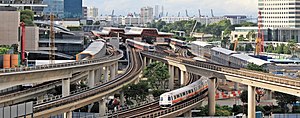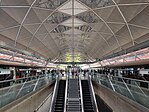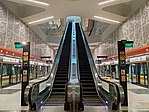| Mass Rapid Transit (MRT) | |||
|---|---|---|---|
 | |||
|
From top, left to right: Entrances of the Toa Payoh, Little India stations; Exterior of Jurong East station; East–West Line (EWL) platforms at Expo station and Thomson–East Coast Line platforms at Caldecott station | |||
| Overview | |||
| Native name | Pengangkutan Gerak Cepat (Malay)[1] 新加坡地铁系统 (Chinese) சிங்கப்பூர் துரிதக் கடவு ரயில் (Tamil) | ||
| Owner | Land Transport Authority | ||
| Locale | Singapore | ||
| Transit type | Rapid transit | ||
| Number of lines | 8[note 1] | ||
| Number of stations | 187[note 2] | ||
| Daily ridership | 3.5 million (2023)[2][note 3] | ||
| Annual ridership | 1.3 billion (2023)[note 3] | ||
| Website | |||
| Operation | |||
| Began operation | 7 November 1987 | ||
| Operator(s) | SMRT Trains SBS Transit | ||
| Character | Fully grade separated | ||
| Number of vehicles | ~579 trains[note 4] comprising >2,600 carriages[note 5] | ||
| Train length | 3–8 carriages[note 6] | ||
| Headway | Peak: 1–3 minutes Off-peak: 5–7 minutes[3] | ||
| Technical | |||
| System length | 241 km (150 mi)[note 7] | ||
| Track gauge | 1,435 mm (4 ft 8+1⁄2 in) standard gauge | ||
| Minimum radius of curvature | 400–500 m (1,312.34–1,640.42 ft) (mainline), 190 m (623.36 ft) (depot)[4] | ||
| Electrification | 750 V DC third rail[a] 1,500 V DC overhead catenary[b] | ||
| Top speed | 78–100 km/h (48–62 mph) (service) 90–100 km/h (56–62 mph) (design) | ||
| |||
The Mass Rapid Transit system, locally known by the initialism MRT, is a rapid transit system in Singapore and the island country's principal mode of railway transportation. The system commenced operations in November 1987 after two decades of planning with an initial 6 km (3.7 mi) stretch consisting of five stations. The network has since grown to span the length and breadth of the country's main island – with the exception of the forested core and the rural northwestern region – in accordance with Singapore's aim of developing a comprehensive rail network as the backbone of the country's public transportation system,[note 8] averaging a daily ridership of 3.45 million in 2023.[2][note 9]
The MRT network encompasses approximately 241 km (150 mi) of grade-separated route on standard gauge. As of 2024, there are currently 141 operational stations[note 10] dispersed across six operational lines arrayed in a circle-radial topology. Two more lines and 46 stations are currently under construction, in addition to ongoing extension works on existing lines. In total, this will schedule the network to double in length to about 460 km (290 mi) by 2040.[6] Further studies are ongoing on potential new alignments and lines, as well as infill stations in the Land Transport Authority's (LTA) Land Transport Masterplan 2040.[7] The island-wide heavy rail network interchanges with a series of automated guideway transit networks localised to select suburban towns — collectively known as the Light Rail Transit (LRT) system — which, along with public buses, complement the mainline by providing a last mile link between MRT stations and HDB public housing estates.[8][note 11]
The MRT is the oldest, busiest, and most comprehensive metro system in Southeast Asia.[note 12] Capital expenditure on its rail infrastructure reached a cumulative S$150 billion[note 13] in 2021, making the network one of the world's costliest on both a per-kilometre and absolute basis.[9][10][11][12][note 14] The system is managed in conformity with a semi-nationalised hybrid regulatory framework; construction and procurement fall under the purview of the Land Transport Authority (LTA), a statutory board of the government that allocates operating concessions to the for-profit private corporations SMRT and SBS Transit. These operators are responsible for asset maintenance on their respective lines, and also run bus services, facilitating operational synchronicity and the horizontal integration of the broader public transportation network.
The MRT is fully automated and has an extensive driverless rapid transit system.[13][14] Asset renewal works are periodically carried out to modernise the network and ensure its continued reliability; all stations feature platform screen doors, Wi-Fi connectivity, lifts, climate control, and accessibility provisions, among others. Much of the early network is elevated above ground on concrete viaducts, with a small portion running at-grade; newer lines are largely subterranean, incorporating several of the lengthiest continuous subway tunnel sections in the world. A number of underground stations double as purpose-built air raid shelters under the operational authority of the Singapore Civil Defence Force (SCDF); these stations incorporate deep-level station boxes cast with hardened concrete and blast doors fashioned out of reinforced steel to withstand conventional aerial and chemical ordnance.
- ^ Zakariah Buang (23 October 1983). "Kerja Bina MRT Dimula". Berita Harian. p. 1.
- ^ a b Loi, Esther (7 February 2024). "Public transport ridership hit 93.5% of pre-pandemic levels in 2023". The Straits Times. Archived from the original on 31 January 2024. Retrieved 15 June 2024.
- ^ "Train Operation Hours and Frequency". Land Transport Authority. Retrieved 9 December 2021.
- ^ "CIVIL DESIGN CRITERIA FOR ROAD AND RAIL TRANSIT SYSTEMS" (PDF). Land Transport Authority. Archived from the original (PDF) on 29 August 2017. Retrieved 22 January 2020.
- ^ "LTA annual report 2021/22" (PDF). Land Transport Authority. p. 44. Retrieved 1 December 2022.
- ^ Toh, Ting Wei (25 May 2019). "New Sungei Kadut MRT station linking North-South and Downtown lines could shorten trips by 30 mins". The Straits Times. Singapore. Archived from the original on 25 May 2019. Retrieved 25 May 2019.
- ^ "LTA LTMP 2040 eReport" (PDF). lta.gov.sg. Land Transport Authority. 2013. Retrieved 23 June 2024.
- ^ Land Transport Authority, Singapore 1996, p. 8.
- ^ "Comparing Singapore's newest and oldest MRT lines". Today. Singapore. 14 November 2017. Retrieved 14 January 2020.
- ^ Abdullah, Zhaki (11 January 2020). "Expect longer waiting times during initial phase of Thomson-East Coast Line: LTA". Channel NewsAsia. Singapore. Archived from the original on 12 January 2020.
- ^ "Oral Reply by Minister for Transport Khaw Boon Wan to Parliamentary Question on Government Subsidies for Operating Costs for the Thomson-East Coast Line" (Press release). Ministry of Transport. Archived from the original on 15 January 2020. Retrieved 15 January 2020.
- ^ Tan, Christopher (28 March 2020). "Almost $100b earmarked for land transport projects". The Straits Times.
- ^ "Réseau express métropolitain". Montreal: CDPQ Infra. 11 July 2017. Archived from the original on 9 February 2018. Retrieved 9 February 2018.
- ^ Briginshaw, David (20 July 2016). "Automated metros set to reach 2200 km by 2025". International Rail Journal. Archived from the original on 15 April 2018. Retrieved 10 February 2018.
Cite error: There are <ref group=note> tags on this page, but the references will not show without a {{reflist|group=note}} template (see the help page).
Cite error: There are <ref group=lower-alpha> tags or {{efn}} templates on this page, but the references will not show without a {{reflist|group=lower-alpha}} template or {{notelist}} template (see the help page).





